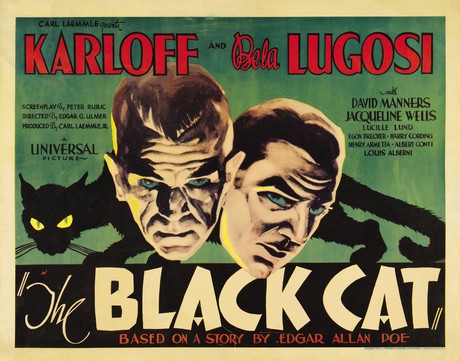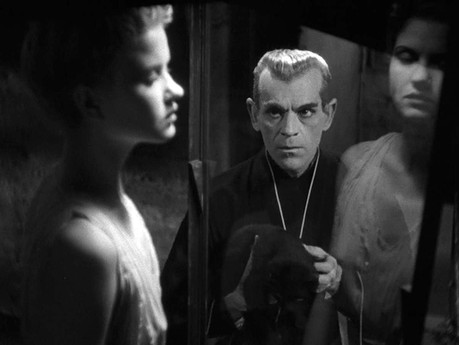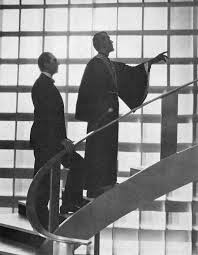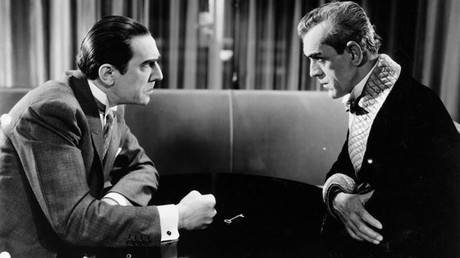Hey guys! Horrorella here...
Welcome back to Celluloid Nightmares, where we explore some of the darkest corners of early horror cinema and uncover (or rediscover) early beloved and terrifying gems. Today, I'm taking a look at Universal's 1934 film, THE BLACK CAT.

Directed by Edgar G. Ullmer, THE BLACK CAT was the first time horror fans saw two of their favorite stars and icons of the Universal horror cycle share the screen. This film would be the first of many collaborations between Bella Lugosi and Boris Karloff, and their onscreen presence is just one of the many things that makes this film resonate to this day.
The film has very little in common with the short story by Edgar Allen Poe from which it takes its name (though it does fly Poe's name in the opening credits), but it still carries its own brand of fright – the film is something of an early psychological horror film, rooting its terror not in the supernatural, but in the horrors that humankind inflicts upon itself.
The story opens on a train with an American couple, Peter (David Manners) and Joan Alison (Julie Bishop, as Jacqueline Wells) beginning their honeymoon in Hungary. They are informed that, due to a booking error, they must share their compartment with psychiatrist Dr. Vitus Werdegast (Lugosi). It's a bit of an uncomfortable fit, made even more uncomfortable when Werdegast creepily begins stroking the sleeping Joan's hair. Peter notices the violation, and by way of apology (it was the 1930's so certainly more important to apologize to the woman's husband, rather than the woman herself), Werdegast confesses that he once had a wife very much like Joan, who he loved dearly. Their life together was cut short when we was called to war and spent fifteen years in a prison camp; he never saw her again.
Despite any creepy entanglements on the train, the trio wind up sharing a bus from the station. When it crashes as a result of a rainstorm, they seek refuge at the home of Hjalmar Poelzig (Karloff), the "old friend" that Werdegast was on his way to visit. It doesn’t take long for the audience to figure out that Werdegast and Poelzig, though certainly acquainted, are hardly friends. They knew each other many years ago, both deeply in love with Karen, the woman that Werdegast would marry and ultimately lose when he went off to war. Not only was Poelzig his romantic rival, but he was also an infamous engineer in the Hungarian army who betrayed his troops to the Russians. Thousands of men died as the result, and Poelzig, in a move of complete douchebaggery, built his elaborate home on top of the battle site.
The audience knows something is off about Poelzig from the moment he appears onscreen. After he has settled the travelers in their rooms, he wanders downstairs to the manor's basement and visits his macabre art installation. Entombed on the walls are the preserved bodies of various women - corpses that have been displayed in a state of never-waking sleep.

When morning arrives, Peter and Joan make several attempts to leave the house and the dark presence of Poelzig, but are foiled at every turn. A train that doesn't leave until midnight, a broken down car, a dead telephone line...it is quickly apparent that Poelzig is set on keeping them present in his house against their will, and they are to be caught in the deadly game of revenge that is finally to be settled between these two men.
What is surprising, as well as notable, is how much ground director Ullmer is able to cover in a brief 65-minute runtime. A strange meeting, wartime wrongs, seeking refuge in a strange place and meeting its grim lord, the revelation of dark secrets, Satanic ritual and one of the most unnerving scenes of revenge of the era all converge within the framework of this story and all have their proper place. Ullmer doesn't waste a second of screentime, and though there are several moments and plot points that are rather disjointed and jarring (the result of some studio notes and reshoots), the film moves along at a steady pace, allowing the horrifying story to unfold at an even clip and culminate grandly.
Also noteworthy design of Castle Poelzig. Given the time period of the film, when Universal was raking in money from the likes of DRACULA and FRANKENSTIEN, plus the nature of the story, a classic Gothic castle seems like an obvious setting. Castle Poelzig, however, is anything but expected. Ullmer, a celebrated production designer on early German films, including METROPOLIS and THE GOLEM, went a completely different route and created something entirely unexpected and memorable. Rather than an antiquated structure filled with dark halls, archways and brick, Poelzig's abode is startling modern and bright, adorned with stainless steel and chrome fixtures, sharp angles and a very Deco look. It is certainly not the setting one would expect from such a tale, yet, is nonetheless foreboding.

The first of many onscreen collaborations, Lugosi and Karloff both give engaging, yet diametrically opposed performances. Karloff's Poelzig is a restrained man. Wooden even, at times, yet the performance is remarkably expressive, with much of the character's diabolical nature and grave intention communicated through Karloff's eyes and subtle facial expressions. Werdegast, on the other hand, is a very expressive character. Lugosi delivers every syllable of dialogue emphatically, and his passion is only magnified by his rolling Hungarian accent. It's really a great balance between the two, particularly when you begin to examine the nature of the characters and their relationship with one another. Poelzig has had the good fortune of spending his post-war years in luxury and comfort, never having to answer for his crimes and enjoying a life free from judgement and retribution. Werdegast, on the other hand, wasted away in prison for fifteen years, losing contact with his wife and daughter, finally emerging as a desperate, broken man who has lost everything.
Werdegast is a fascinating antihero. Given the history between the two men, we are more likely to side with Werdegast in this game, identifying with the pain and sadness that he has endured, but his demeanor and his twisted plan for revenge keep him distanced from the audience. Though we understand his motivations, his presance is just as unnerving as that of his nemesis.
The presence of Peter and Joan are, in fact, something of a shield for the viewer. The young couple is innocent to the horrific past that has befallen these men and this country. Like us, they have simply wandered into wrong place at the wrong time, unable to escape. Ultimately, we are saved from having to identify too strongly with either Werdegast or Poelzig by instead rooting for happy couple and watching two villains set upon destroying one another by whatever means possible, which makes the story all the more fascinating.
Lugosi was reportedly disappointed with an early cut of the film and the way it set him up as yet another villain. Ullmer reshot some of it and gave Werdegast some additional motivations, but doesn’t entirely succeed in making Lugosi the hero he had wanted to be. The character is far too damaged for redemption in the eyes of the audience, and the tormented antihero is perhaps a better addition to the story anyway.

THE BLACK CAT is fascinating in that it does represent an early entry into psychological horror. There is nothing onscreen that is particularly terrifying, but the nature of the dueling antagonists and what they have come to represent carries its own brand of horror, as do the various twists that the plot takes. The story touches on necrophilia, incest, mind control, murder, sex, satanic worship and ritual and some pretty horrific violence, all in varying degrees. And though it never delves too deep into any one area, the film was made prior to the crackdown of the Production Code, and was able to dance around some pretty controversial topics with the narrative.
And though the punishment that Werdegast has in mind for Poelzig at the end of the film is quite grotesque, the true horror in this story builds upon the conflict that exists between these two men. The history that has gone unaddressed until this reckoning over 15 years after their last meeting. The wrongs, committed by Poelgiz, that brought Werdegast to this stage in his life and his psyche, are matched only by the twisted brand of justice that Werdegast is hell bent on inflicting on Poelzig during this visit.
THE BLACK CAT turned out to be another financial and critical success for the studio, and though it might not be known for creating an iconic figure in the Universal horror cycle, it is certainly a memorable film that did a lot of things right. Though it suffered here and there from a rushed story and plot changes, it more than made up for it with its portrayal of loss and revenge. These are memorable performances from both Lugosi and Karloff, and the dark, twisted tale of loss and vengeance that it tells is certainly one to revisit.
